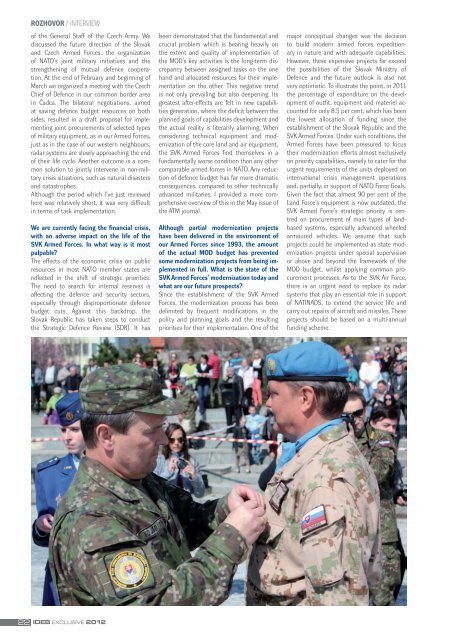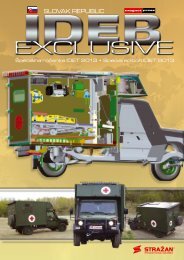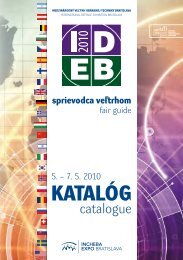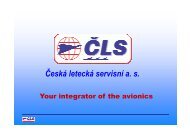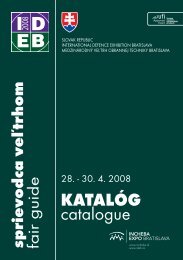tnostà - IDEB â MEDZINÃRODNà VEĽTRH OBRANNEJ TECHNIKY ...
tnostà - IDEB â MEDZINÃRODNà VEĽTRH OBRANNEJ TECHNIKY ...
tnostà - IDEB â MEDZINÃRODNà VEĽTRH OBRANNEJ TECHNIKY ...
Create successful ePaper yourself
Turn your PDF publications into a flip-book with our unique Google optimized e-Paper software.
ROZHOVOR / INTERVIEW<br />
of the General Staff of the Czech Army. We<br />
discussed the future direction of the Slovak<br />
and Czech Armed Forces, the organization<br />
of NATO’s joint military initiatives and the<br />
strengthening of mutual defence cooperation.<br />
At the end of February and beginning of<br />
March we organized a meeting with the Czech<br />
Chief of Defence in our common border area<br />
in Čadca. The bilateral negotiations, aimed<br />
at saving defence budget resources on both<br />
sides, resulted in a draft proposal for implementing<br />
joint procurements of selected types<br />
of military equipment, as in our Armed Forces,<br />
just as in the case of our western neighbours,<br />
radar systems are slowly approaching the end<br />
of their life cycle. Another outcome is a common<br />
solution to jointly intervene in non-military<br />
crisis situations, such as natural disasters<br />
and catastrophes.<br />
Although the period which I’ve just reviewed<br />
here was relatively short, it was very difficult<br />
in terms of task implementation.<br />
We are currently facing the financial crisis,<br />
with an adverse impact on the life of the<br />
SVK Armed Forces. In what way is it most<br />
palpable?<br />
The effects of the economic crisis on public<br />
resources in most NATO member states are<br />
reflected in the shift of strategic priorities.<br />
The need to search for internal reserves is<br />
affecting the defence and security sectors,<br />
especially through disproportionate defence<br />
budget cuts. Against this backdrop, the<br />
Slovak Republic has taken steps to conduct<br />
the Strategic Defence Review (SDR). It has<br />
been demonstrated that the fundamental and<br />
crucial problem which is bearing heavily on<br />
the extent and quality of implementation of<br />
the MOD’s key activities is the long-term discrepancy<br />
between assigned tasks on the one<br />
hand and allocated resources for their implementation<br />
on the other. This negative trend<br />
is not only prevailing but also deepening. Its<br />
greatest after-effects are felt in new capabilities<br />
generation, where the deficit between the<br />
planned goals of capabilities development and<br />
the actual reality is literarily alarming. When<br />
considering technical equipment and modernization<br />
of the core land and air equipment,<br />
the SVK Armed Forces find themselves in a<br />
fundamentally worse condition than any other<br />
comparable armed forces in NATO. Any reduction<br />
of defence budget has far more dramatic<br />
consequences, compared to other technically<br />
advanced militaries. I provided a more comprehensive<br />
overview of this in the May issue of<br />
the ATM journal.<br />
Although partial modernization projects<br />
have been delivered in the environment of<br />
our Armed Forces since 1993, the amount<br />
of the actual MOD budget has prevented<br />
some modernization projects from being implemented<br />
in full. What is the state of the<br />
SVK Armed Forces’ modernization today and<br />
what are our future prospects?<br />
Since the establishment of the SVK Armed<br />
Forces, the modernization process has been<br />
delimited by frequent modifications in the<br />
policy and planning goals and the resulting<br />
priorities for their implementation. One of the<br />
major conceptual changes was the decision<br />
to build modern armed forces expeditionary<br />
in nature and with adequate capabilities.<br />
However, these expensive projects far exceed<br />
the possibilities of the Slovak Ministry of<br />
Defence and the future outlook is also not<br />
very optimistic. To illustrate the point, in 2011<br />
the percentage of expenditure on the development<br />
of outfit, equipment and materiel accounted<br />
for only 8.5 per cent, which has been<br />
the lowest allocation of funding since the<br />
establishment of the Slovak Republic and the<br />
SVK Armed Forces. Under such conditions, the<br />
Armed Forces have been pressured to focus<br />
their modernization efforts almost exclusively<br />
on priority capabilities, namely to cater for the<br />
urgent requirements of the units deployed on<br />
international crisis management operations<br />
and, partially, in support of NATO Force Goals.<br />
Given the fact that almost 90 per cent of the<br />
Land Force’s equipment is now outdated, the<br />
SVK Armed Force’s strategic priority is centred<br />
on procurement of main types of landbased<br />
systems, especially advanced wheeled<br />
armoured vehicles. We assume that such<br />
projects could be implemented as state modernization<br />
projects under special supervision<br />
or above and beyond the framework of the<br />
MOD budget, whilst applying common procurement<br />
processes. As to the SVK Air Force,<br />
there is an urgent need to replace its radar<br />
systems that play an essential role in support<br />
of NATINADS, to extend the service life and<br />
carry out repairs of aircraft and missiles. These<br />
projects should be based on a multi-annual<br />
funding scheme.<br />
22 <strong>IDEB</strong> EXCLUSIVE 2012


